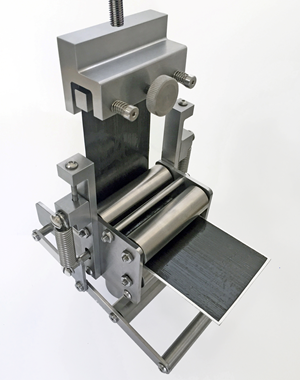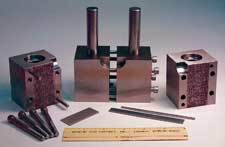Back-out factors
Dr. Adam's follows up a previous column, in which he discussed the advantages of testing a cross-ply laminate and then "backing out" the unidirectional composite strength, with an expanded examination of back-out factors that can be applied to other types of laminates.
In my previous column, I discussed the advantages of testing a cross-ply laminate and then "backing out" the unidirectional composite strength. This included both tensile and compression testing.
A cross-ply laminate was defined as a composite with all plies oriented at 0° or 90°; that is, any one of the [0/90] family of laminates, with arbitrary numbers and distributions of 0° and 90° plies. However, it was indicated that one could back out unidirectional strength from other, more general laminates, but not as advantageously.
The concept of using back-out factors has been discussed repeatedly since the mid-1980s1,2 and, in 1992, the Suppliers of Advanced Composite Materials Assn. (SACMA) introduced "recommended methods" for testing cross-ply laminates in both tension3 and compression4 and then backing out the unidirectional composite strength. A simple formula was presented in both documents for calculating the unidirectional composite strength from measured cross-ply strength, by multiplying the latter by the following factor,
BF = 2E11/(E11 + E22) (1)
where E11 and E22 represent the measured axial and transverse stiffnesses of the unidirectional composite. This unnamed factor was designated as F in the SACMA documents, but has now commonly come to be called the back-out factor, since the unidirectional composite strength is "backed-out" of the cross-ply strength experimental data. Thus, in Eq. 1, I have used the more descriptive BF.
Actually, the back-out factor given in Eq. 1 is a very simplified rule-of-mixtures approximation of the rigorous laminated plate theory equation, neglecting all Poisson's ratio effects. As written, it applies only to [0/90]ns laminates, i.e., cross-ply laminates containing equal numbers of 0° and 90° plies. But note that it is actually just the ratio of the axial stiffness of the unidirectional plies to that of the cross-ply laminate, a simple approximation that could be used for other laminates in the [0/90] family as well.
The general laminated plate theory equation for any balanced, symmetric laminate is5,
BF = (Q°11A22 - Q°12A12) t/ (A11A22 - A212) (2)
where Q°ij are terms in the reduced (plane stress) stiffness matrix for a 0° ply, the Aij
(The subscript i and j represent combinations of "1" and "2" as indicated in Eg. 2.) This equation can be evaluated readily using a relatively simple computer program5.
Of course, Eq. 2 can be simplified for any specific laminate. For example, for a [0/90]ns cross-ply laminate it can be reduced to:
BF = [1/2E11(E11+ E12) - (v12 E12)2] / [1/4(E11 + E22)2 - (v12 E22)2] (3)
where E11 and E22 are the axial and transverse stiffnesses of the 0° plies and v12 is the major Poisson's ratio. These are all readily measured properties.
Similar equations can be obtained for other types of laminates. However, the equations for laminates that contain other than 0° and 90° plies do become more complicated because of the shear coupling that exists. Note that Eq. 3 contains no shear or shear-coupling terms. That is, the shear stiffness properties of the unidirectional ply or of the laminate do not enter into the calculation. This is a distinct advantage of the [0/90] family of laminates since classical lamination theory is a linear analysis and shear stress-shear strain properties can be very nonlinear. Influences of material nonlinearity are discussed in detail by Welsh and Adams5. Fortunately, the influences usually are not severe. Likewise, for most composites the back-out factor is not strongly influenced by even moderate uncertainties in the values of E22 and n12. For these reasons, a [0/90]ns cross-ply laminate is the logical choice for use in backing out unidirectional composite properties.
The question then arises, "Is the behavior of a [0/90]ns laminate test specimen representative of actual composite laminates used in design?" To answer this question, Adams and Welsh6 compression tested a variety of laminate configurations fabricated from the same carbon/epoxy composite material. Most of these laminates were in the [0], [0/90], [0/±60], [0/±30/90] and [0/±45/90] families, with wide variations in the ratio of 0° plies to off-axis plies. They also gathered from the published literature similar experimental data generated by others. The corresponding back-out factors were then calculated.
Fig. 1 is a plot of the backed-out unidirectional composite axial compressive strength of these widely varying laminates versus the calculated back-out factor. Each data point represents the average of multiple individual specimen tests, typically five or more. The plot is divided into General Laminates and Special Laminates, the division being at a back-out factor of approximately 2.5, corresponding to a [0/±45/90]ns (quasi-isotropic) laminate. Note that a back-out factor of 1 corresponds to a unidirectional composite. The unidirectional composite data presented in Fig. 1 were obtained using special test techniques, i.e., thickness-tapered specimens and mini-sandwich specimens6. The large number of data points at a back-out factor of approximately 1.8 are for [0/90]ns laminates.
The Special Laminates have progressively higher back-out factors, representing laminates having increasingly higher ratios of off-axis plies to 0° plies. Note that the corresponding backed-out unidirectional composite axial strengths become increasingly higher as well. Values as high as 3,000 MPa (435 ksi) are indicated in Fig. 1. Experimental evidence suggests that the large number of off-axis plies surrounding the few 0° plies tends to restrict the fibers in the 0° plies from micro-buckling6. That is, the true compressive strength of the fibers is being approached. Unfortunately this is not achieved in commonly used (general) laminates, where micro-buckling is very evident in failed compression specimens.
General laminates used in design typically range between the extremes of unidirectional composites (the most highly orthotropic composite possible) and quasi-isotropic composites. In design, there is seldom a reason to go outside this range, into the realm of special laminates, since the composite axial stiffness becomes progressively lower. Note that the experimental data in the range of general can be represented reasonably a horizontal line, as shown in Fig. 1. That is, for all general (practical) laminates, the backed-out 0° ply axial compressive strength is essentially constant, with [0/90]ns laminates in the middle of the range. This is the design value of compressive strength for practical laminates.
Fig. 1 is for compressive strength and for only one composite material. Although some other materials have been similarly analyzed, and tensile tests have been conducted as well, obviously much more testing should be done. Nevertheless, even what has been presented here should be a very convincing indication that back-out factors can be used, and that a [0/90]ns laminate is a good choice when doing so.
References:
1 Rawlinson, R.A., "The Use of Crossply and Angleply Composite Test Specimens to Generate Improved Material Property Data," Proceedings of the 36th International SAMPE Symposium, April 1991, pp. 1058-1068.
2 Hart-Smith, L.J., "Backing Out Equivalent Unidirectional Lamina Strengths from Tests on Cross-Plied Laminates," Proceedings of the 37th International SAMPE Symposium, March 1992, pp. 977-990.
3 SACMA SRM 9-94, "SACMA Recommended Test Method for Tensile Properties of Oriented Cross-Plied Fiber-Resin Composites," Suppliers of Advanced Composite Materials Assn. (Arlington, Va.), April 1994 (first issued as SRM 9-92 in 1992).
4 SACMA SRM 6-94, "SACMA Recommended Test Method for Compressive Properties of Oriented Cross-Plied Fiber-Resin Composites," Suppliers of Advanced Composite Materials Assn. (Arlington, Va.), April 1994 (first issued as SRM 6-92 in 1992).
5 Welsh, J.S., and Adams, D.F., "Testing of Angle-Ply Laminates to Obtain Unidirectional Composite Compression Strengths," Composites, Part A, Vol. 28A, 1997, pp. 387-396.
6 Adams, D.F., and Welsh, J.S., "The Wyoming Combined Loading Compression (CLC) Test Method," Journal of Composites Technology & Research, Vol. 19, No. 3, 1997, pp. 123-133.
Related Content
Plant tour: National Institute for Aviation Research, Wichita, Kan., U.S.
NIAR, located at Wichita State University in the heart of the American aerospace manufacturing industry, has evolved to become a premier hub of teaching, R&D, creativity and innovation.
Read MoreComposite prepreg tack testing
A recently standardized prepreg tack test method has been developed for use in material selection, quality control and adjusting cure process parameters for automated layup processes.
Read More3D-printed CFRP tools for serial production of composite landing flaps
GKN Aerospace Munich and CEAD develop printed tooling with short and continuous fiber that reduces cost and increases sustainability for composites production.
Read MoreASCEND program update: Designing next-gen, high-rate auto and aerospace composites
GKN Aerospace, McLaren Automotive and U.K.-based partners share goals and progress aiming at high-rate, Industry 4.0-enabled, sustainable materials and processes.
Read MoreRead Next
Testing cross-ply vs. unidirectional composites
Dr. Don Adams follows up his previous column on tensile testing with a discussion of such testing when confronted by two difficult-to-test laminate configurations.
Read MoreComposites end markets: Energy (2024)
Composites are used widely in oil/gas, wind and other renewable energy applications. Despite market challenges, growth potential and innovation for composites continue.
Read MoreCW’s 2024 Top Shops survey offers new approach to benchmarking
Respondents that complete the survey by April 30, 2024, have the chance to be recognized as an honoree.
Read More












.jpg;maxWidth=300;quality=90)














